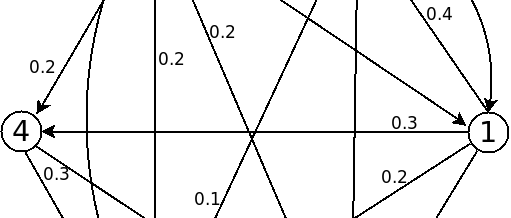
I’m feeling the need to write something about the hybrid reputation/money system called Quantified Prestige I’m working on. Even though the full documentation of Quantified Prestige has been online for quite some time, I haven’t announced it publicly on this blog, yet. So, I’m doing that now.
Quantified Prestige is a system that can be used for building a full-fledged reputation based economy. At the moment it is only a theoretical system, as I’m still haven’t finished its first software implementation. Ok, so what is a reputation based economy good for? First of all, it is a good answer to the question how to reward the creators of free open-source software and similar socially beneficial products. Intrinsic motivation is good, but it doesn’t pay bills.
Now the idea of a reputation economy is that you care more about certain reputation indexes that you have than how much money you earn. You work primarily for reputation and not for money. Still, that doesn’t pay any bills, so my idea was to couple reputation with money, so that your reputation determines how much you earn. I developed a system around this idea that I first called Repo Fluido, then Prestige Fluido, and finally Quantified Prestige.
Quantified Prestige is modular. There is a core system, the Quantified Prestige Network (QPN) and there are apps who interact with this core system. The QPN is all about implementing a positive reputation index called Prestige. You get Prestige by convincing others that you are worth Esteem Points which they can allocate to you. So far this looks like a simple karma system, for example like that on Reddit. What’s special in Quantified Prestige is that each user has a fixed contingent of Esteem Points (EPs) which she can allocate, but not transfer to others. Allocating means that you can “donate” EPs, but you can take these EPs back at any time for any reason. Taking back EPs is actually necessary if you have used up your full contingent of EPs and want to donate some of them to a new user for example. The fixed contingent of EPs basically serves to eliminate “reputation inflation” which basically kills badly designed reputation systems. The EPs you get translate into Prestige, modified by things called Spread and Trust Factors. Prestige is good, because Prestige is a precious and relatively scarce sign of acknowledgement by others.
Interacting apps can use the Prestige Scores for doing reputation dependent stuff, like paying out money in proportion to the Prestige of a user. That money can be any conventional currency, but electronic currencies can be handled easier by software. I’ve also developed a native electronic currency for the Quantified Prestige system: The Fluido. What’s interesting about Fluido is that it’s a currency that can flow continuously. Fluido is generated continuously by Prestige and can be transferred continuously between different accounts.
Overall, Quantified Prestige is a really versatile system that may be used by all kinds of organizations and social networks as a democratic and meritocratic rewarding mechanism. Quantified Prestige can fundamentally change how our social, economic, and political systems work. It can liberate us from the necessity of trading (of work, goods or services) to get an income. Just doing something publicly useful, even if it’s something you can hardly make any money now, will be enough to earn a living. There will be a strong positive economic incentive for individuals and organizations to behave in a universally beneficial manner. Even if this comes with a few problems, it will finally make this world a better place.
As I’ve mentioned earlier, I’m working on an open source software implementation of Quantified Prestige. If you have experience with Python, Django, PostgreSQL, or building web applications in general, your support could help me to create a useful version of Quantified Prestige faster.
Further plans include a decentralized architecture for Quantified Prestige and a platform for setting up and interfacing Quantified Prestige Networks easily. This will make Quantified Prestige resilient, useful, and comfortable.
Let’s create the future!
P.S.: Here are the full documentations:
- Prestige Fluido (old name of Quantified Prestige) documentation V0.01
- Quantified Prestige documentation V0.02
OCT
2012



 Twitter
Twitter Facebook
Facebook GooglePlus
GooglePlus RSS
RSS